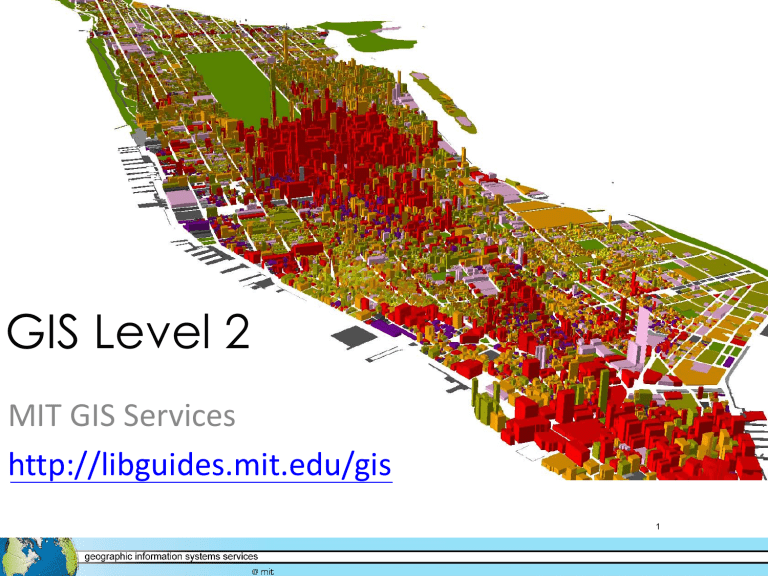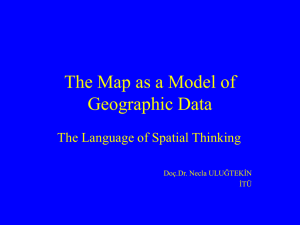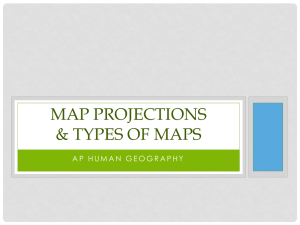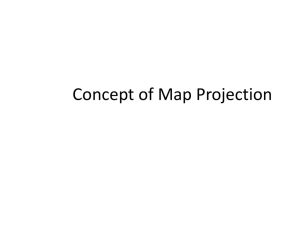GIS Level 2 MIT GIS Services

GIS Level 2
MIT GIS Services http://libguides.mit.edu/gis
1
What will you learn today?
•
How to use metadata and map projections to understand and transform geographic data
•
How do use processing tools in ArcGIS and
QGIS to perform a multi-step analysis
•
How to automate this analysis using a model
2
What is analysis in a GIS?
•
Using tools within a GIS to examine the attributes and location of spatial data and reveal relationships that you might not be able to see otherwise.
3
Examples of GIS Analyses
•
Determine clusters of high and low values using spatial statistical tools, such as where there is a statistically significant cluster of high median home values.
4
Examples of GIS Analyses
•
Extract elevation values from a Digital Elevation
Model to determine where rivers will form, flow direction, and watersheds.
5
MAP PROJECTIONS IN
ANALYSIS
6
Map Projections
There are many types of map projections. Each projection has certain strengths and also introduces one or more of the following types of distortion:
•
Shape
•
Area
•
Distance
•
Direction
More information on the GIS Services Website in Resources by Topic: http://libguides.mit.edu/content.php?pid=347508&sid=2844938
7
Map Projections
Geographic Coordinate
Systems
•
Use a 3D spherical surface to define locations
•
Units are in degrees
Projected Coordinate Systems
•
Use a flat, 2D surface
•
Constant lengths, angles and areas across the two dimensions
•
Units in feet, meters, miles, etc.
•
The exact map projection determines how the data are distorted when transformed from 3D to 2D.
8
Map Projections
•
Part of your analysis model may involve a map projection transformation.
•
Some analysis tools that involve distance or area calculations will require your data to be in a projected coordinate system.
•
Although not required, you should transform
your data into the same coordinate system for the most accurate results when performing an analysis.
9
Map Projections
Define the projection of a data layer
•
If the software doesn’t understand what the projection is then it will not be able to overlay it in the correct location. A data layer must be defined as what it is according to the metadata. Defined shapefiles will have a .
prj file.
Project a data layer into a new projection
•
This is commonly done to match the projection of other files you are working with or to select an appropriate projection for the location and type of analysis you plan to do. The projection of the data layer must be properly defined before it can be projected.
Choose a projection to display your overall map in by adjusting the properties of your data frame (ArcGIS) or project (QGIS) . ArcGIS and QGIS can do “projection on the fly”, so data layers in your project do not all have be in the same projection.
10
Map Projections
Changing and Defining Projections in ArcGIS:
• http://blogs.esri.com/esri/supportcenter/2013/08/23/whento-use-the-define-projection-tool-and-the-project-tool-2/
Changing and Defining Projections in QGIS:
• https://docs.qgis.org/2.2/en/docs/user_manual/working_wit h_projections/working_with_projections.html
11
How do you know if your data has a defined map projection?
How do you know what it is?
•
Look for a .prj file as part of the shapefile.
•
Open the file in QGIS or ArcGIS and examine
the data layer information.
•
Read the metadata.
12
Metadata
•
Information about the data layer
•
Read the metadata to determine who created the data, when it was created, what the codes in the table mean, if there are constraints on how it can be used, etc.
•
You can find metadata:
–
Downloaded with your data layers
–
On the website where you got your data
–
Sometimes you may need to contact the data provider to get metadata
•
Metadata is most commonly in html/xml format, text files, or in a table format, such as excel or csv.
13
Metadata
14
Metadata
15
PROCESSING TOOLS
16
We will use processing tools in this workshop to:
•
Narrow down a larger dataset
•
Aggregate and analyze demographic data
•
Pinpoint areas for development
•
Identify suitable locations
17
Definition Query
•
Define what you want to be (and not to be) displayed on your map
•
Also applies to any analysis performed afterward
Example: UN Member States only
18
Adding XY Data
•
A table with columns of
X and Y coordinates can be converted into points
•
You must know the coordinate system beforehand
•
Example: Towns in
Lesotho Africa
19
•
Only features and parts of features within a boundary layer are retained
•
The input layer can be a point, line, or polygon, but the clip layer must be a polygon
Clip
Example: European railroad layer clipped for France
20
Buffer
•
Creates a polygon surrounding a feature at a given distance
•
Can be around a point, line, or polygon
•
Dissolve or create separate features
•
Examples: 50 miles around mines and 5 miles around rivers in
Angola
21
Intersect
•
Takes two layers and combines them in a geometric intersection, retaining only space common to both layers
•
Example: Kansas City urbanized area (one feature) and states
(Kansas and Missouri) result in two features for urbanized area in each state
22
Dissolve
Example: Counties dissolved into regions based on a field in the attribute table
•
Aggregates features based on specified attributes
•
Choose a field to create new features
•
Choose whether multipart features should be created (i.e. non-adjacent features should be combined)
23
Select by Location
•
Creates a selection in one layer based on some spatial relationship between that layer and another
•
Example: Storage facilities in Myanmar (Burma) are selected
24
Spatial Join
•
Join the table information from two files, based on their spatial relationship.
•
Relationship options:
Intersect, contains, closest, within
Example: Associate census tract numbers with business data to explore demographics and potential customers of a neighborhood.
25
Models
•
Enables users to develop a workflow of their methodology
•
A process consisting of multiple steps can be collapsed into one tool.
•
A model can be edited as a python script to run multiple iterations.
• A model can be saved and shared on different machines and with other users.
•
An image of a model is commonly used for documenting a process – in a thesis for example.
26
Geocoding
•
Automatically plot address lists on a map
•
Download Address locators from the IS&T ArcGIS download page or create your own. They are also on machines in the GIS lab.
•
QGIS offers online geocoding tools using OpenStreetMap or Google.
27
Create and Edit Features
•
New shapefiles can be created from scratch
•
Features can be edited or created using the editor toolbar
Example: creating a major road layer for
Havana, Cuba based on an aerial image base map
28
SOFTWARE
29
QGIS and ArcGIS
•
ArcGIS (commercial/proprietary) and QGIS
(open source) are the most popular GIS software programs.
•
The interfaces look very similar and many of the same analysis tools can be found in each program.
•
You may find some analyses are easier in QGIS and some in ArcGIS.
30
Today’s Workshop Exercise
•
Where are the most suitable sites for a new, large apartment complex in Manhattan?
•
This exercise will take into account the following factors:
–
Parcel vacancy
–
Distance to subway station
–
School district
–
Zoned land use
31
MIT OpenCourseWare http://ocw.mit.edu
RES.STR-001 Geographic Information System (GIS)Tutorial
January I AP 2016
For information about citing these materials or our Terms of Use, visit: http://ocw.mit.edu/terms .



